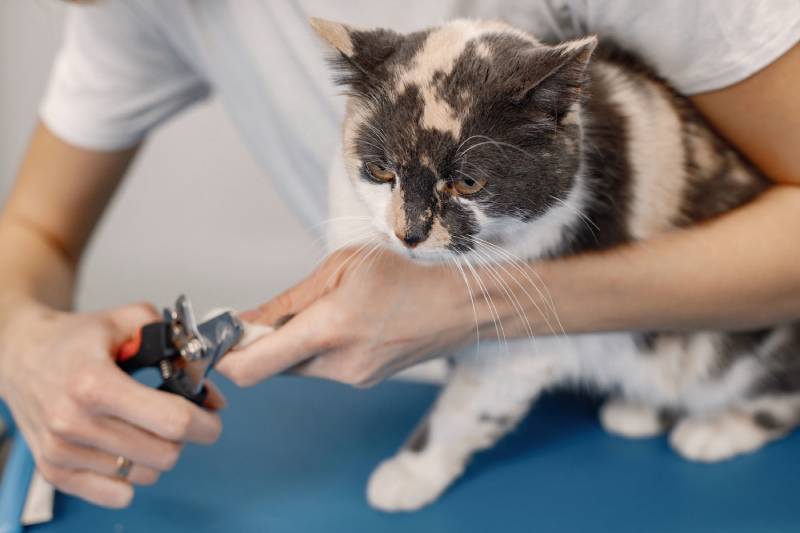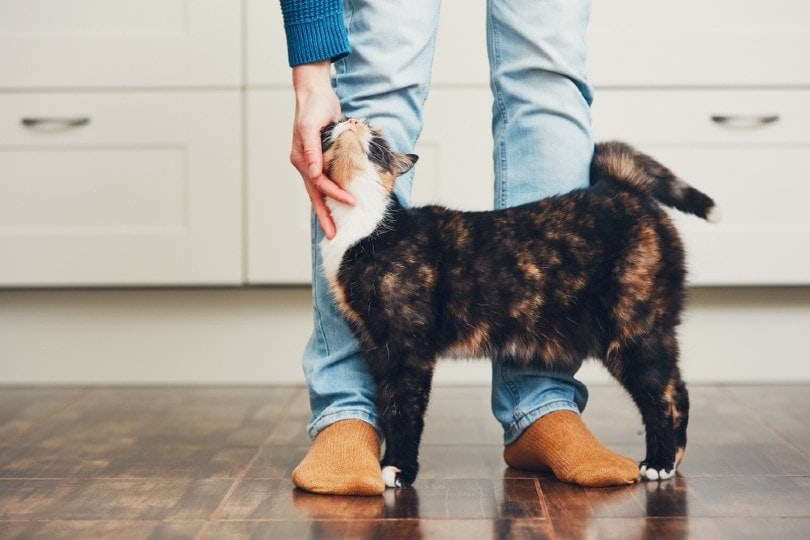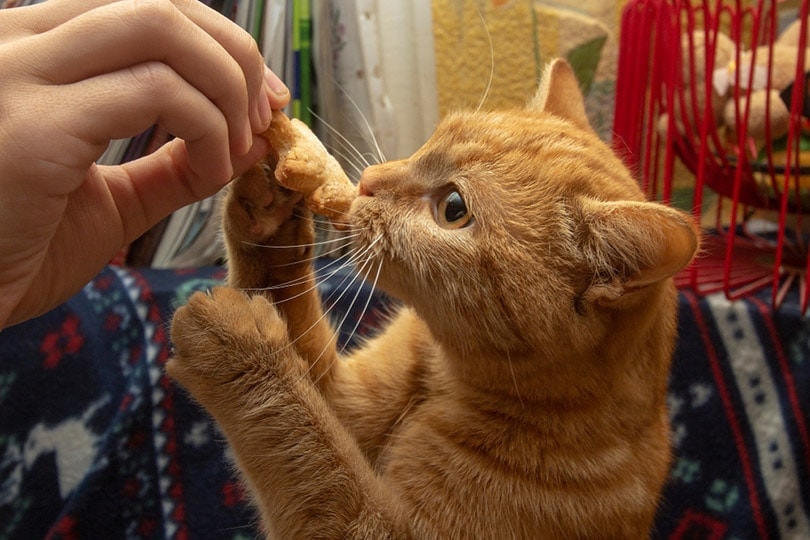Toyger Cat: Info, Pictures, Characteristics & Facts
Updated on

| Height: | 9 – 13 inches |
| Weight: | 7 – 15 pounds |
| Lifespan: | 9 – 13 years |
| Colors: | Tiger-like—brown, reddish-brown, orange, with tabby stripes |
| Suitable for: | Active households |
| Temperament: | Outgoing, active, friendly |
The Toyger is a domestic breed that is the result of selectively breeding tabby cats to more closely resemble tigers. These cats are not crosses with wild cats. Instead, they are completely domestic—selective breeding as simply made them look like tigers.
Because this species is newer, there are very few of them out there. Therefore, finding them is extremely rare, and they are often quite expensive.
They are recognized by The International Cat Association and have advanced through all the steps to be a championship breed. They even have their own breed association, where you can locate breeders and current litters.1
Toyger Kittens
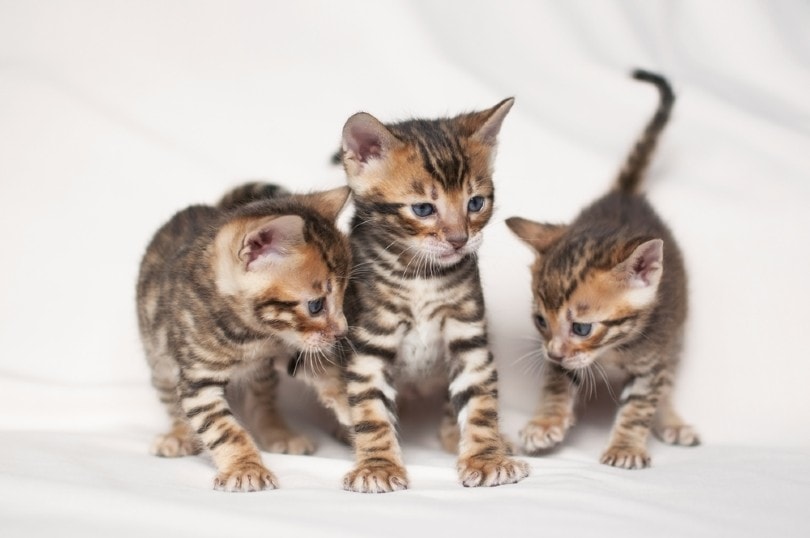
Compared to other cats, Toyger kittens are quite expensive. Typically this is because there are very few breeders. And since there is not much competition over prices, it all just depends on the breeder.
Luckily, these cats are known for being decently healthy. Therefore, you won’t have to pay huge amounts of veterinary bills. However, you should keep in mind the full cost of ownership before you dive into purchasing a kitten of any breed.
3 Little-Known Facts About the Toyger
1. They were bred to encourage tiger conservation
These “toy tigers” were bred by their founder to inspire cat-lovers to care for the tigers currently in the wild.
2. They have their own breed association.
Because these cats are rare and newer, many people don’t realize that they have their own breed association, which keeps up with breeders and pedigrees. Therefore, finding one of these cats isn’t just a huge shot in the dark.
Despite how they look, these cats are not actually related to any wild feline. They are simply the result of careful selective breeding, which has made the cats look like tigers.
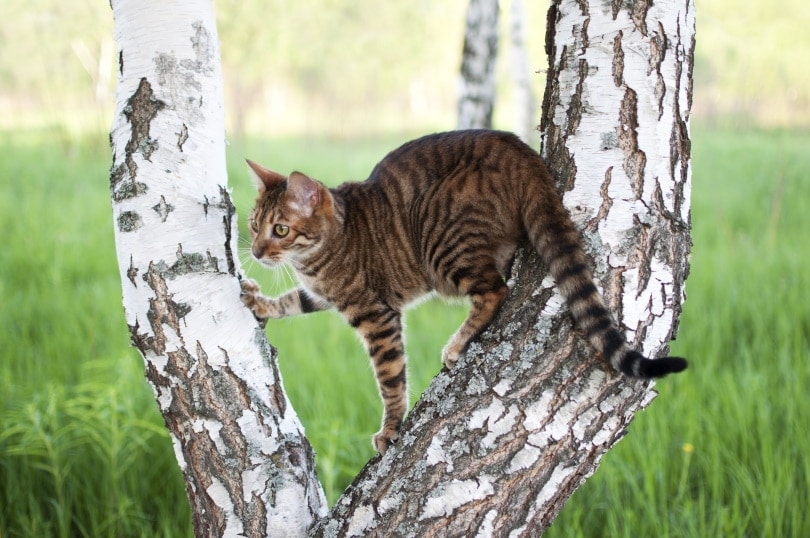
Temperament & Intelligence of the Toyger
For the most part, these cats act like any other domestic feline. They were not bred for their personalities but for their looks. Therefore, their personalities can differ widely and are not very standardized. In fact, there is nothing about their personality at all in the breed standards.
Still, because all of these cats are the result of selective breeding, there are some common characteristics. They tend to be on the more active side. Therefore, they aren’t the best for those only looking for a cuddle buddy. You will have to play and exercise them quite a bit.
Often, this breed is considered to be outgoing and friendly. They aren’t completely people-oriented like other breeds out there but they are typically not shy or scared of people, which leads to them becoming more friendly.
Because they are related to the Bengal, some of these felines can easily learn tricks and walk on a leash. They have been known to play fetch and take part in agility competitions. For cat owners looking to be a bit more involved with their felines, this species is a great option for you.
These cats are also quite smart and they need some mental stimulation. They are not cats that will spend most of their day laying around and sleeping. They need something to do. Therefore, we highly recommend that their potential owners consider purchasing puzzle toys and similar interactive toys to keep these felines entertained.
Are These Cats Good for Families? 👪
These cats aren’t any more or less good for families than your typical feline. They have a personality that is pretty similar to your average cat, besides their slightly higher activity needs and intelligence. They usually aren’t scared of children, which can make them a good option for homes that have smaller children.
Furthermore, they do best in larger active families where something is going on all the time. They bore easily, so having multiple family members for them to interact with is best.
With that said, they also do just fine when adopted by an individual or couple—as long as they are interacted with regularly. They are not best for someone that is going to be at work for much of the day, for instance.
Does This Breed Get Along with Other Pets?
Yes. Usually, they do get along just fine with other pets. They are pretty energetic, so more active pets may be the best fit. They may be a bit much for laidback cats and older dogs, for instance.
They are not typically scared of dogs, so that isn’t usually a problem that you have to deal with. If your dog is friendly towards cats, they should get along just fine with this one. With that said, your dog’s personality is going to matter much more than the cat in this instance. An aggressive dog will likely be unable to get along with this cat, even though this cat is typically good with canines.
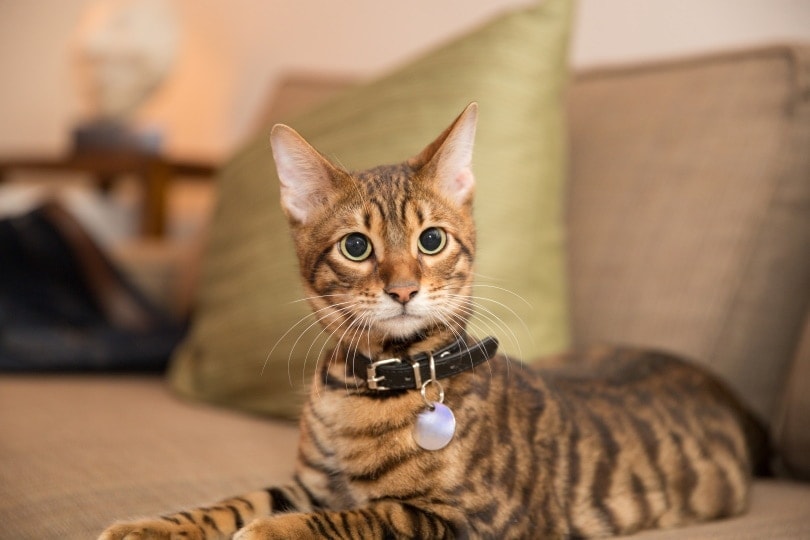
Things to Know When Owning a Toyger
Food & Diet Requirements 🐡
As an active cat, the Toyger usually goes through more calories a day than your average feline. Therefore, they do best on a high-protein diet or one with more calories overall. They are basically tiny athletes, so they need to be fed like one.
Beyond that, they do not have any particular dietary needs. They are not prone to any health conditions that commonly need to be handled by dietary changes, and they aren’t particularly prone to obesity, either.
We recommend feeding them quality cat food that is specifically high in protein and calories. Of course, keep an eye on their body condition. If they begin to gain too much weight, be sure to speak to your vet about potentially changing their food.
Exercise 🐈
As we’ve stated, these cats are quite active. They will need cat condos, climbing structures, and toys to keep them entertained and active. These sorts of cats will literally climb your curtains if you leave them to their own devices. Luckily, they are smart enough to train, so they pick up on what’s appropriate and what isn’t very quickly.
However, you will still have to provide them with outlets for their energy. Otherwise, their training won’t matter much.
These cats are also plenty smart enough to walk on a leash, and their outgoing personality means that they typically aren’t scared of going for walks. We highly recommend taking these cats on walks after training to help them get some of their energy out.
We do not recommend these cats for owners looking for a cuddle buddy or a cat that is going to sleep much of the day. Instead, they’re best for active owners who want a feline to take out and enjoy life with.
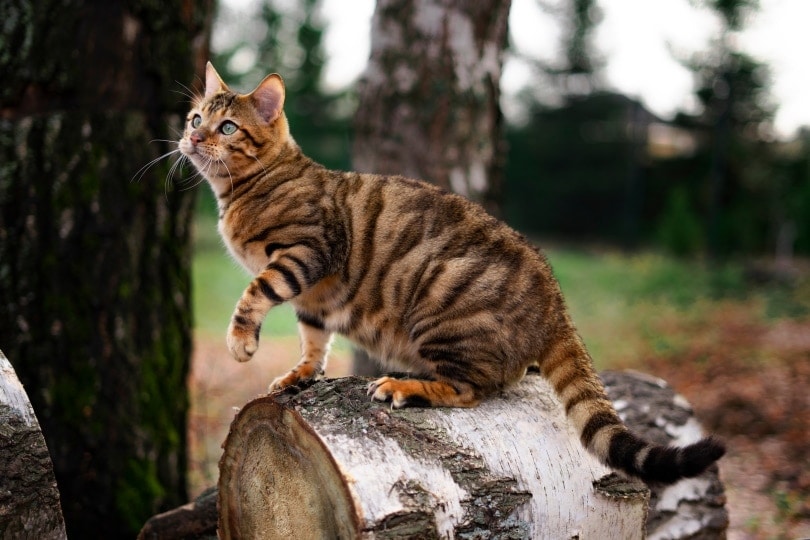
Training 🧶
Because these cats are smarter, they are quite easy to train. However, they are not “dog-like,” so training will look a bit different. Use positive reinforcement just like you would with a dog, but plan on training sessions being on the cat’s schedule, not yours.
Dogs are typically very happy to please and willing to train whenever you ask them. Cats? Not so much. You’ll likely need to invite your cat to train using treats, but don’t expect them to respond every time. Patience is key here.
Training sessions will likely also be shorter, so cats tend to lose interest quite fast. Therefore, little and often is key. Make a routine of it—perhaps practicing around mealtimes.
We recommend starting with a few basic commands first, like sitting. Then, work on walking on a leash. Using a leash is an extremely practical matter that these cats need to learn. It makes getting in the proper exercise much easier.
Grooming ✂️
Like most cats, Toygers don’t need much grooming. They have short fur so brushing won’t be necessary. Your cat will be able to take care of most of their own grooming needs.
However, we do recommend keeping an eye on the state of their coat. A cat with a distended coat can have a variety of problems, including certain diseases and infections. For instance, obese cats often have a harder time taking care of their coat and often cannot reach certain places. In this case, you may have to give them a bit of help (and talk to your vet about adjusting their diet).
You will need to help your cat with nail health, especially if they are indoor cats. While cats would wear down their own nails in the wild, this is not the case with domestic cats. Scratching posts and climbing structures can help, just be sure you teach your cat what they can and can’t use for scratching.
Even with plenty of scratching structures, some cats will still need their nails trimmed. You can have a vet or groomer do this if you are uncomfortable. However, there are also plenty of devices on the market designed for use at home, such as nail grinders.

Health and Conditions 🏥
- Obesity
- Heart murmurs
Toygers are a newer and rarer breed. Therefore, we don’t really know much about their health. Not enough cats have been born yet for us to draw conclusions about diseases they are prone to. As of now, these cats are only prone to a few conditions.
However, this may change in the future as we learn more about them. For instance, there have not been any current studies done on these cats, but that is sure to change in the future when they become more popular.
Generally, we recommend that you select a breeder that provides a health guarantee. Kittens should also be involved with the household of the breeder (not set apart for “health reasons”). Preferably, the breeder will run some health tests on the parents before breeding. However, this may not be the case with this breed, since they are not known to be particularly prone to any certain health conditions.
The only know predisposition these cats have is to heart murmurs, which may indicate hypertrophic cardiomyopathy. However, this disposition has not been widely studied—just reported through anecdotal evidence. Therefore, we don’t know if these heart murmurs are serious or completely normal.
The best way to ensure that your Toyger stays healthy is to help them maintain a healthy weight. Obesity is a problem with practically all cat breeds. While the Toyger is not as prone as some other species, they can still become obese if improperly fed or exercised.
Male vs. Female
There is nothing particularly different about the males or females of this breed. Males are sometimes larger than females, but this is not always the case. Generally, these cats appear larger than they actually are. They tend to be rather bulky, especially if they are males.
The only temperament differences between these cats are the usual hormonal ones. Females will go into heat, which will indicate personality changes. Usually, they will yowl and even mark to attract a mate during this time. Males tend to get antsy if they locate a female in heat. However, they are not prone to the same hormonal fluctuations as females.
We highly recommend that you spay or neuter any cat that you don’t plan on breeding. This will prevent some behavioral problems and even health conditions.
Final Thoughts
The Toyger is a rare breed that was bred to resemble wild tigers. They are a mix of a few different domestic breeds. However, despite how they look, they are 100% domesticated. No wild cats were used to create them.
They are considered to be friendly, outgoing, and active. They’re smart enough to learn many tricks and walk on leashes thanks to their Bengal cousins. However, they are not considered “dog-like” like many other intelligent breeds. They act very similarly to your average domestic feline (because that’s really what they are – genetically speaking).
We do recommend them for active households. They need a bit of mental and physical stimulation, so they seem to be best for larger families that have plenty of individuals to give them attention. However, they would also work for an active couple or individual that spends a lot of time at home.
Breeders are often difficult to come by, as there are very few in the USA. The last breeder count was done in 2012, and there were only about 15 breeders (and many had a different breed as their “main”). While those numbers have likely increased over the past few years, there are still far fewer of these cats than you might expect.
Featured Image Credit: Kutikova Ekaterina, Shutterstock


